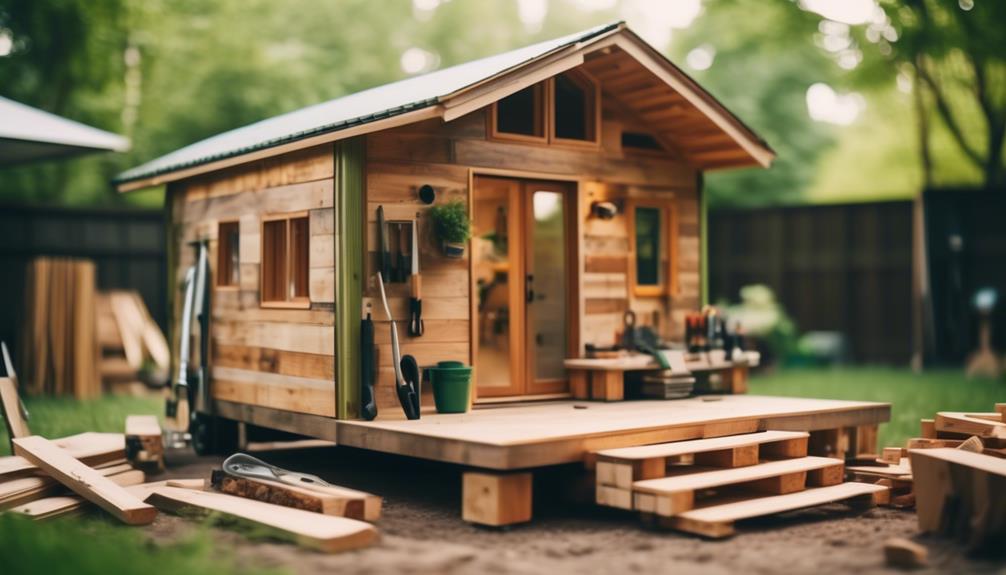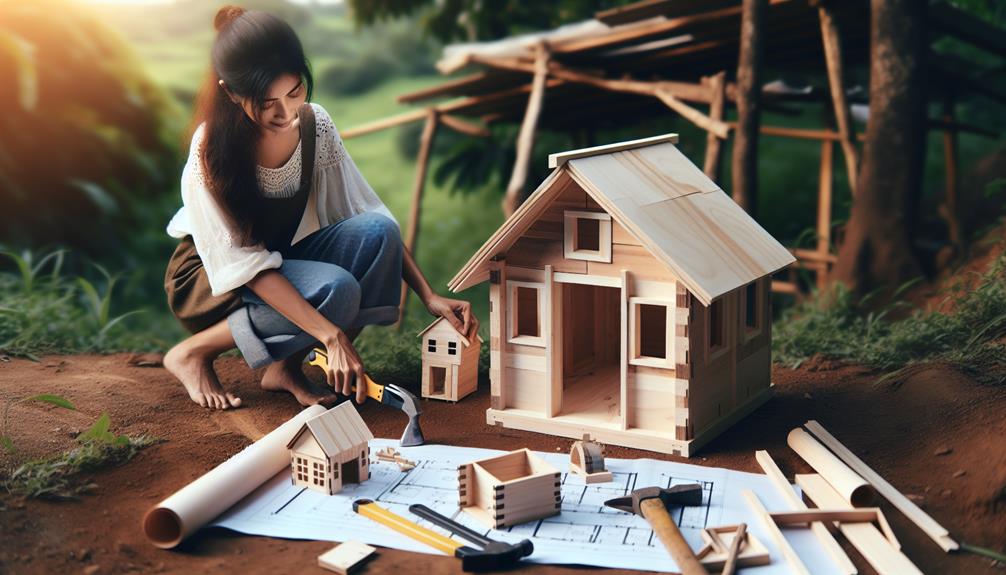In the vast expanse of the housing market, your dream home could be the smaller, more sustainable option that's just within your reach; yet, you're faced with the question of whether you can actually build it yourself. You've seen the charming pictures, read the inspiring stories, and now you're considering if you have what it takes to construct your own tiny home.
As a professional guide, I'm here to walk you through the process, ensuring you don't overlook the crucial steps that could turn your dream into a durable reality. From the initial design to the last nail, you'll find that the journey of creating something with your own hands is as intricate as the homes themselves.
Stay with me, and I'll help you discern the tools you'll need, the skills you'll develop, and the satisfaction you'll earn as each piece comes together, paving the way for a life less ordinary.
Key Takeaways
- Assess your building skills and experience before starting a DIY tiny home construction project.
- Prioritize adaptability in the design of your tiny home, maximizing living space without compromising functionality.
- Research and source materials that meet local building codes and your budget, considering suppliers experienced in tiny home construction.
- Regularly inspect and maintain your tiny home, focusing on areas such as the roof, windows, doors, plumbing, and electrical systems.
Assessing Your Capabilities
Before diving into the construction of your tiny home, it's crucial to realistically evaluate your building skills and experience to ensure you're up to the task. Tackling a DIY project like this means the work must align with local building codes and standards. If you're uncertain about your capabilities, consider hiring a pro to save money and headaches in the long run.
Start building your knowledge base by researching the step-by-step build process and cost of building. Remember, the DIY route isn't just about putting up walls; it's about ensuring your tiny home is safe and sustainable. Seek professional advice for areas outside your expertise.
The success of your tiny home depends on a solid foundation—both literally and in terms of your construction skills.
Designing Your Tiny Home
When designing your tiny home, prioritize adaptability and consider how lifestyle changes might influence your spatial needs and layout choices.
Begin by researching Tiny House Plans that reflect your vision and comply with local codes.
As you start to design, focus on a floor plan that maximizes living space without compromising functionality. Find a place for everything by planning efficient storage and selecting multi-functional furniture.
Opt for durable, low-maintenance materials and a simple roof to ease future upkeep.
Follow a step-by-step guide to ensure each phase of your Tiny House Design aligns with best practices.
Sourcing Materials and Tools

Gathering the right materials and tools is a critical step in bringing your tiny home from design to reality. This process requires thorough research and careful selection to ensure both quality and cost-effectiveness.
To begin, it's important to dive into the tiny house movement with a sharp eye for building materials that meet building codes without breaking your tight budget. Start by crafting a detailed materials list from your DIY tiny house plans. This will help you stay organized and ensure that you have everything you need before you begin construction.
Once you have your list, the next step is to hunt down suppliers who specialize in tiny home construction. Look for suppliers who have experience working with tiny homes and can offer guidance and support throughout the process.
One aspect that should not be overlooked is the importance of a sturdy trailer. A trailer serves as the foundation for your tiny home, so it's crucial to find a manufacturer that offers custom options such as square fenders and undercarriage flashing. This will help ensure that your tiny home is built on a solid and reliable base.
Additionally, it's essential to secure direct links to purchase roofing material, tools, and other essentials. Having these resources readily available will streamline the building process and save you time and effort.
Construction Steps Overview
Having secured your materials and tools, it's time to outline the construction steps for your tiny home, starting with a solid foundation and moving through to the final touches on your new, compact living space.
Begin by selecting a stable place to build, ensuring your tiny house on wheels or stationary structure rests on a reliable base.
Next, frame your tiny house floor, walls, and roof, meticulously following blueprints. The steps I took include prioritizing insulation, installing windows and doors, and setting up functional plumbing and electrical systems.
Don't forget to seal your tiny home build against the elements with proper siding and roofing.
As a final step, customize the interior to your taste, making it truly innovative and reflective of your tiny living dream.
Maintenance and Upkeep Tips

To ensure your tiny home remains a haven of comfort and safety, it's vital to perform regular maintenance and address any issues as they arise. Keeping up with maintenance and upkeep tips will not only prolong the life of your home but also ensure it remains efficient and safe. Here's a practical table to guide you:
| Maintenance Area | Tips |
|---|---|
| Roof Design & Metal Roofing | Inspect for damage, ensure proper sealing |
| Water Heater & Carbon Monoxide | Regularly service to prevent leaks, install detectors |
| Windows, Doors & Fascia Boards | Check seals, clean tracks, and inspect for rot |
| Foundation & House Wrap | Examine the permanent foundation, check house wrap integrity |
Remember to periodically clean your water heater, ensure your tiny home can efficiently heat and cool, and keep an eye on the structural integrity from the roof to the foundation.
Frequently Asked Questions
Can I Build a Tiny House by Myself?
You can build a tiny house solo, but assess your skills, understand zoning challenges, and secure building permits. Prioritize design, space optimization, and eco-friendly materials while ensuring structural integrity and sourcing the right tools.
How Much Does It Cost to Build a Tiny Home From Scratch?
Ironically, building tiny homes isn't always a small expense. You'll navigate budget planning, material selection, and foundation costs. Factor in design, utilities, legalities, and potential resale. Maximize space and consider eco-friendly, off-grid features.
How Long Does It Take to Build a Tiny House by Yourself?
Building a tiny house solo takes 2-6 months, factoring in your skill level, work pace, project planning, phases, material procurement, permit acquisition, weather, potential delays, and your dedication to the construction process.
How to Build Tiny House Cheap?
"A penny saved is a penny earned," especially when you're building a tiny house cheaply. Utilize budget materials, repurpose fixtures, and embrace design simplicity. Attend community workshops and consider DIY insulation and solar solutions.
Conclusion
In the end, remember that 'a stitch in time saves nine.'
By meticulously following this guide, you've set the stage for a sturdy tiny home. Keep up with regular maintenance and don't shy away from seeking professional help when needed.
Your hard work and dedication are the cornerstones of your tiny home's durability and charm. Now, step back and admire your handiwork – a true testament to self-reliance and ingenuity.

